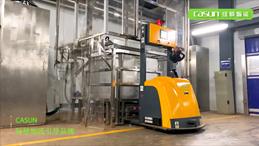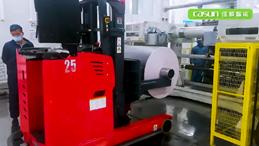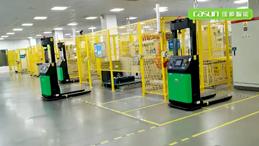 Focus on AGV industry for 18 years
Focus on AGV industry for 18 years
 Focus on AGV industry for 18 years
Focus on AGV industry for 18 years
As the core logistics equipment in the production process of new energy, mobile robots are widely used in the new energy industry due to their advantages such as small space occupation, flexibility, high fault tolerance, and high efficiency intelligence.
AGV mobile robots with fork-lift capabilities can directly pick up and transport materials (pallets), automatically reduce speed when turning, and have functions such as automatic obstacle recognition and timely obstacle avoidance, making them safe and reliable when moving. They are mainly used for raw material distribution on production lines, transportation of semi-finished and finished products, and material stacking in factory warehouses. They can replace humans to complete some monotonous, frequent, high-intensity, and long-term repetitive operations, or operations under dangerous and harsh environments.
CASUN's representative products: C5-B1, C5-B2, C5-B3, C5-D1, C5-D3, C5-D5, C5-D6.
Application scenario 1 for fork-lift AGV mobile robots: Transport of positive electrode materials in the front-end process
Project requirements: A smart logistics upgrade project for the transportation of positive electrode materials in a new energy lithium-ion upstream material company is needed to achieve intelligent logistics for the factory's material transportation process.
Solution:
1) This project uses 38 laser-guided fork-lift AMRs, 7 sets of automatic charging piles, and automatic weighing systems;
2) The robot's automatic distribution is achieved through data collection by the automatic weighing system, and integration with the production management system to meet the weight requirements.

Project effectiveness and benefits:
1) Reducing the number of workers;
Reducing logistics distribution personnel and equipment docking personnel, optimizing the operation process, saving 2-3 people per production line, and improving efficiency by more than 30%;
2) System integration;
Smart system integration achieves the ultimate goal of unmanned and intelligent from both software and hardware perspectives;
3) Increased degree of intelligence;
Seamless connection between AGV/AMR robots and various processes, data linkage, and improved level of factory intelligence.
Application scenario 2 for fork-lift AGV mobile robots: Transport of rolled materials in the front-end process
Project requirements: An intelligent transport project for strip pieces in a new energy lithium-ion production factory primarily aimed at upgrading the transportation process of copper/aluminum foil and strip piece cache boxes. The project consists of processes such as coating, coating application, and rolling, with a complex workflow and involves transportation across multiple floors.
Solution:
1) This project of the AGV manufacturer uses five laser-guided fork-lift AMRs, warehouse management systems, AGV management systems, and, together forms a smart logistics solution for rolled materials in the new energy lithium-ion industry;
2) Integration with on-site automation equipment, essentially realizing automatic ordering;
3) Integration with the elevator control system, essentially achieving autonomous elevator access.

Project effectiveness and benefits:
1) Reducing fixed equipment investment costs: with a flexible process improvement, using AGV pallet truck can help save 5 million yuan in costs;
2) Improving the yield rate and accuracy: reducing the defect rate by 85%, reducing material damage during handling, and improving transport accuracy to 99%, meeting full-line production peaking demands;
3) Intelligent management: optimized allocation of storage location, route, and tasks.
Application scenario 3 for fork-lift AGV mobile robots: Transport of module products in the back-end process
Project requirements: A transport project for module products in a new energy lithium-ion enterprise's module product library is needed to transport battery module trays intelligently and automatically between the warehouse and production lines.
Solution:
1) This project uses 7 CASUN intelligent stacking fork-lift F10 series AMRs, 3 automatic charging systems, etc;
2) By integrating with the customer's system, the robot could order the products on its own, and achieve the automation of stock in and out of battery module trays;

Project effectiveness and benefits:
1) Reducing equipment and manpower investment costs;
2) Improving the timeliness of material transportation, with transport accuracy improved to 99% and full-line production peaking demands met;
3) Enhancing product transportation safety, ensuring product yield;
4) Achieving full process monitoring and tracking, production data collection, statistical analysis, and reporting of the entire production process to achieve intelligent and automated production workflow.